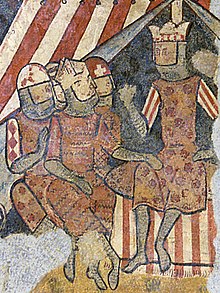
The military history of Catalonia began in the thirteenth century, with the first exploits of the armies under the orders of Catalan rulers and lasting until today, where Catalan soldiers are integrated into international forces.[ citation needed ]

The military history of Catalonia began in the thirteenth century, with the first exploits of the armies under the orders of Catalan rulers and lasting until today, where Catalan soldiers are integrated into international forces.[ citation needed ]

The origins of military force in the Catalonia date back to the thirteenth century, with the Sagramental, the brotherhood among several peoples to guarantee their own security, made by oath, and, therefore, called this way. Though they were institutionalised during the reign of James I, they had already been legislated in writing during the 11th century. In Catalonia, the usage Princeps namque established the requirement that every man participate in the national defense in the event of external threat.
The history of the Mediterranean has often tasted Catalan weapons, from Murcia to Athens and Neopatria (Great Catalan Company), but also to old Catalonia, before and after the Nueva Planta decrees (1716).
The Catalans, Aragonese and Valencians have been organized spontaneously militarily in many different ways, from the Sagramental, the Crusades of the Almogavars to the maulets, the submissive ones, or the maquis. Until the Nueva Planta decrees, in Catalan homes there were always weapons and ammunition to defend themselves, either from the Saracens, the pirates or the French.[ citation needed ]
It is not therefore until after the defeat of the War of the Spanish Succession that the new Bourbon authorities limited and controlled the right to bear arms, and under the pretext of pacifying the country, it hides the desire to prevent citizens from rising in Weapons against it, as had happened many times. [1]


In addition, the Catalan constitutions, abolished in fact by the Decree, forced the Crown to negotiate the popular support, represented by the arm seal (an institution that convened the Provincial Council of the General in an extraordinary way in cases of emergency or urgency) of the catalan courts, support that they often granted in exchange for privileges, which limited the royal authority. This balance of powers disappears after the defeat, and humiliation becomes apparent in many ways, such as the demolition of La Ribera quarter, where there was more resistance, the construction of the fortress of the Ciutadella in the same place, the imposition of the Cadastre, or the closure of all Catalan universities.
For this reason, when they saw the difference of the concept of royal authority in Castile, the Catalans rose up with Charles VI, Holy Roman Emperor, handed out posters of propaganda and negotiated with England.
The Abandonment of the Allies of Catalonia in the war of Spanish succession "Treaty of utrecht" supposed the Victory of the Bourbon monarchy Support with Castille versus Habsburg Support with Aragon Crown: (Principality Of Catalonia, The Kingdom of Aragon, Kingdom of Valencia and Kingdom of Mallorca) that Centralized power and eliminated rights and freedoms of the nations surrounding the Castille Nation with New Plant Decree.
The deplorable History of The catalans [2] written by Queen Anne of England or The case of the catalans document of several European foreign ministries reflect that abandonment.
The Crown of Aragon has been considered an empire which ruled in the Mediterranean for hundreds of years, with the power to set rules over the entire sea(for instance, the Llibre del Consolat del Mar or Book of the Consulate of the Sea , written in Catalan, is one of the oldest compilation of maritime laws in the world). It was indeed, at its height, one of the major powers in Europe.

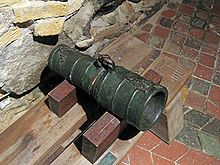
« ...e la nostra nau desparà una bombarda e ferí en lo castell de la nau de Castella... »
— Cròniques dels reis d'Aragó e comtes de Barcelona
Pistols:
Submachine guns:
Assault rifles:
Shotguns:
Sniper rifles:
Heavy weapons:
Armoured Vehicles


The lands of what today is known as Catalonia, in Spain, were first settled during the Middle Palaeolithic era. Like the rest of the Mediterranean side of the Iberian Peninsula, the area was occupied by the Iberians and several Greek colonies were established on the coast before the Roman conquest. It was the first area of Hispania conquered by the Romans. It then came under Visigothic rule after the collapse of the western part of the Roman Empire. In 718, the area was occupied by the Umayyad Caliphate and became a part of Muslim ruled al-Andalus. The Frankish Empire conquered the area from the Muslims, ending with the conquest of Barcelona in 801, as part of the creation of a larger buffer zone of Christian counties against Islamic rule historiographically known as the Marca Hispanica. In the 10th century the County of Barcelona became progressively independent from Frankish rule.

The count of Barcelona was the ruler of the County of Barcelona and also, by extension and according with the Usages and Catalan constitutions, of the Principality of Catalonia as Princeps for much of Catalan history, from the 9th century until the 18th century. After 1164, with Alfonso II of Aragon and I of Barcelona, the title of count of Barcelona was united with that of king of Aragon, and after the 16th century, with that of king of Spain.

The Kingdom of Aragon was a medieval and early modern kingdom on the Iberian Peninsula, corresponding to the modern-day autonomous community of Aragon, in Spain. It should not be confused with the larger Crown of Aragon, which also included other territories—the Principality of Catalonia, the Kingdom of Valencia, the Kingdom of Majorca, and other possessions that are now part of France, Italy, and Greece—that were also under the rule of the King of Aragon, but were administered separately from the Kingdom of Aragon.
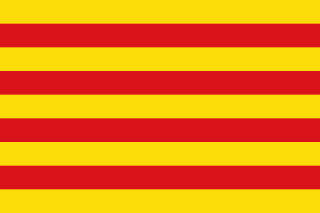
The Crown of Aragon was a composite monarchy ruled by one king, originated by the dynastic union of the Kingdom of Aragon and the County of Barcelona and ended as a consequence of the War of the Spanish Succession. At the height of its power in the 14th and 15th centuries, the Crown of Aragon was a thalassocracy controlling a large portion of present-day eastern Spain, parts of what is now southern France, and a Mediterranean empire which included the Balearic Islands, Sicily, Corsica, Sardinia, Malta, Southern Italy and parts of Greece.
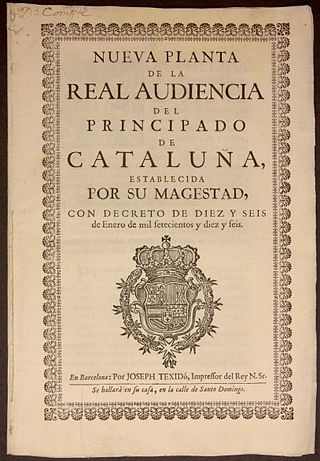
The Nueva Planta decrees were a number of decrees signed between 1707 and 1716 by Philip V, the first Bourbon King of Spain, during and shortly after the end of the War of the Spanish Succession by the Treaty of Utrecht.
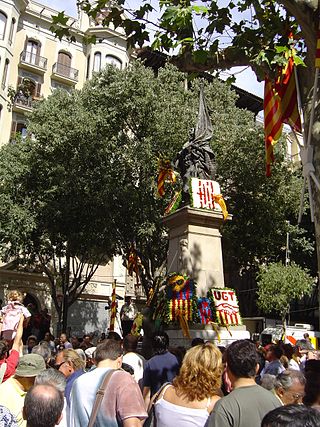
The National Day of Catalonia is a day-long festival in Catalonia and one of its official national symbols, celebrated annually on 11 September. It commemorates the fall of Barcelona during the War of the Spanish Succession in 1714 and the subsequent loss of Catalan institutions and laws.

The Parliament of Catalonia is the unicameral legislature of the autonomous community of Catalonia. The Parliament is currently made up of 135 members, known as deputies, who are elected for four-year terms or after extraordinary dissolution, chosen by universal suffrage in lists of four constituencies, corresponding to the Catalan provinces. The Parliament building is located in Ciutadella Park, Barcelona.

The Principality of Catalonia was a medieval and early modern state in the northeastern Iberian Peninsula. During most of its history it was in dynastic union with the Kingdom of Aragon, constituting together the Crown of Aragon. Between the 13th and the 18th centuries, it was bordered by the Kingdom of Aragon to the west, the Kingdom of Valencia to the south, the Kingdom of France and the feudal lordship of Andorra to the north and by the Mediterranean Sea to the east. The term Principality of Catalonia was official until the 1830s, when the Spanish government implemented the centralized provincial division, but remained in popular and informal contexts. Today, the term Principat (Principality) is used primarily to refer to the autonomous community of Catalonia in Spain, as distinct from the other Catalan Countries, and usually including the historical region of Roussillon in Southern France.
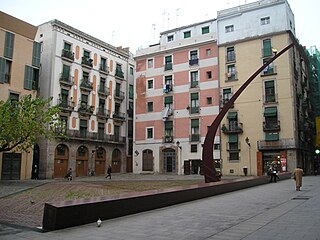
The Fossar de les Moreres is a memorial square in Barcelona, adjacent to the basilica of Santa Maria del Mar. The plaza was built over a cemetery where defenders of the city were buried following the Siege of Barcelona at the end of the War of the Spanish Succession in 1714. The plaza features a memorial to the fallen Catalans of the war, with a torch of eternal flame and a heroic poem by Frederic Soler, "El Fossar de les Moreres".
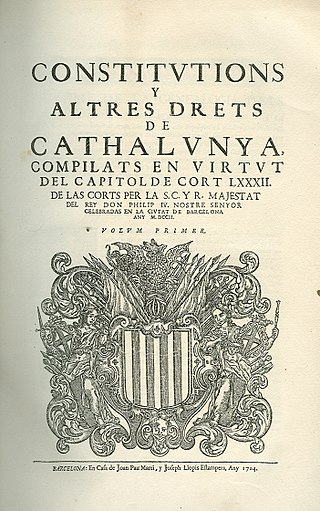
The Catalan constitutions were the laws of the Principality of Catalonia promulgated by the Count of Barcelona and approved by the Catalan Courts. The Corts in Catalan have the same origin as courts in English but instead meaning the legislature. The first constitutions were promulgated by the Corts of 1283. The last ones were promulgated by the Corts of 1705. They had pre-eminence over the other legal rules and could only be revoked by the Catalan Courts themselves. The compilations of the constitutions and other rights of Catalonia followed the Roman tradition of the Codex.

The County of Barcelona was a polity in northeastern Iberian Peninsula, originally located in the southern frontier region of the Carolingian Empire. In the 10th century, the Counts of Barcelona progressively achieved independence from Frankish rule, becoming hereditary rulers in constant warfare with the Islamic Caliphate of Córdoba and its successor states. The counts, through marriage, alliances and treaties, acquired or vassalized the other Catalan counties and extended their influence over Occitania. In 1164, the County of Barcelona entered a personal union with the Kingdom of Aragon. Thenceforward, the history of the county is subsumed within that of the Crown of Aragon, but the city of Barcelona remained preeminent within it.

Catalonia is internally divided into eight regional divisions, known in Catalan as vegueries, following the regional plan of Catalonia. Each vegueria is further divided into comarques and municipalities, with the exception of the Aran Valley, considered a "unique territorial entity".

Anti-Catalanism is the collective name given to various historical trends in France, Italy, and Spain that have been hostile to Catalan culture and traditions.
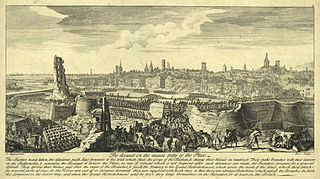
The siege of Barcelona was a thirteen month battle at the end of the War of Spanish Succession, which pitted Archduke Charles of Austria against Philip V of Spain, backed by France in a contest for the Spanish crown.

The Catalan counties were the administrative Christian divisions of the eastern Carolingian Hispanic Marches and the southernmost part of the March of Gothia in the Pyrenees created after their rapid conquest by the Franks.
The title Count or Countess of Cervera is one of the titles of the heir of the Crown of Spain. Its current holder is Leonor, Princess of Asturias, heiress to Felipe VI. Cervera is the capital of the comarca of Segarra, in the province of Lleida, Catalonia. The title specifically represents the heir to the Kingdom of Valencia, a part of the Crown of Aragon.
Corregimiento is a Spanish term used for country subdivisions for royal administrative purposes, ensuring districts were under crown control as opposed to local elites. A corregimiento was usually headed by a corregidor.

The Catalan Courts or General Court of Catalonia were the policymaking and parliamentary body of the Principality of Catalonia from the 13th to the 18th century.